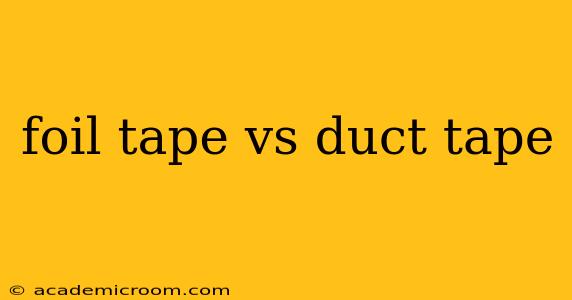Choosing between foil tape and duct tape often depends on the specific task at hand. While both are adhesive tapes with seemingly similar applications, their distinct properties make them suitable for vastly different purposes. This comprehensive guide will delve into the key differences, helping you make the right choice for your next project.
What is Foil Tape?
Foil tape, also known as aluminum foil tape, consists of a thin layer of aluminum foil bonded to a pressure-sensitive adhesive. This construction gives it unique properties not found in duct tape. Its primary strength lies in its reflective and insulating qualities, making it ideal for tasks requiring heat resistance, vapor barriers, and shielding from electromagnetic interference (EMI).
What is Duct Tape?
Duct tape, also called gaffers tape or cloth tape, is a versatile adhesive tape known for its strength and durability. It’s made from a flexible polyethylene plastic film backing that’s coated with a strong adhesive. Its robust nature makes it a go-to for temporary repairs, bundling, and securing items.
Foil Tape vs. Duct Tape: A Detailed Comparison
Here's a breakdown of the key differences to help you decide which tape best suits your needs:
Material & Construction:
- Foil Tape: Aluminum foil backing with a pressure-sensitive adhesive.
- Duct Tape: Polyethylene plastic film backing with a strong adhesive.
Adhesiveness:
- Foil Tape: Generally has a strong, but not as aggressive, adhesive as duct tape. The adhesive is designed for long-term adhesion, especially on smooth surfaces.
- Duct Tape: Boasts a very strong, aggressive adhesive that can stick to almost any surface, even rough ones. However, the adhesive can be difficult to remove cleanly.
Temperature Resistance:
- Foil Tape: Excellent heat resistance, often used in high-temperature applications.
- Duct Tape: Limited heat resistance; it can become brittle and lose its adhesive properties at higher temperatures.
Water Resistance:
- Foil Tape: Offers good water resistance, acting as a vapor barrier.
- Duct Tape: Provides some water resistance, but not as effective as foil tape, especially over extended periods.
Applications:
- Foil Tape: HVAC ductwork sealing, repairing flashings on roofs, creating heat shields, protecting surfaces from heat damage, EMI shielding.
- Duct Tape: Temporary repairs (e.g., patching holes, securing packages), bundling cables, securing items during transport, craft projects.
Frequently Asked Questions (FAQ)
This section addresses common queries surrounding foil tape and duct tape.
Can I use duct tape instead of foil tape?
While duct tape might seem like a suitable substitute in some situations due to its readily available nature, it's generally not recommended as a replacement for foil tape in applications requiring heat resistance, water sealing, or EMI shielding. Duct tape lacks the necessary properties for these specialized applications.
Which tape is better for outdoor use?
For long-term outdoor use, foil tape is generally a better choice due to its superior weather resistance. Duct tape can withstand some weather exposure, but its durability decreases significantly over time.
Which tape leaves less residue?
Foil tape typically leaves less residue when removed, particularly on smooth surfaces. Duct tape's aggressive adhesive can be challenging to remove completely and may leave a sticky residue.
What is the best way to remove duct tape?
Carefully peel back the edge of the duct tape, slowly and at a low angle. Using a hairdryer on a low setting can help soften the adhesive, making removal easier. For stubborn residue, rubbing alcohol or adhesive remover can be applied.
Can foil tape be used on painted surfaces?
Foil tape can be used on painted surfaces, but test it on an inconspicuous area first to ensure it doesn't damage the paint or leave residue upon removal.
Which tape is more expensive?
Generally, foil tape is more expensive than duct tape, reflecting its specialized properties and materials.
Conclusion: Choosing the Right Tape
The choice between foil tape and duct tape ultimately hinges on the intended application. Foil tape excels in situations requiring heat reflection, insulation, and water resistance, while duct tape is a more versatile, readily available option for general-purpose repairs and securing items. Understanding their distinct properties will help you select the right tape for the job, ensuring a successful outcome.
